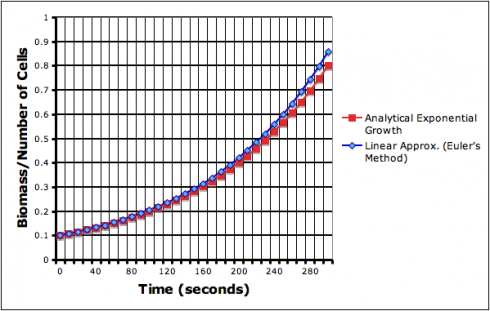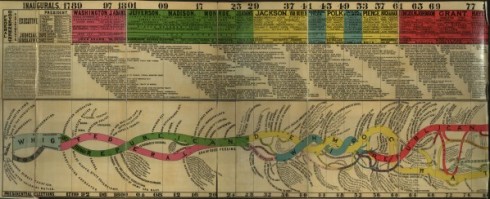
Anatronica has an excellent, online, 3d viewer for the anatomy of the human torso. While it’s not quite the same as a physical model, it’s pretty good as a study guide for middle schoolers.
Middle and High School … from a Montessori Point of View

Anatronica has an excellent, online, 3d viewer for the anatomy of the human torso. While it’s not quite the same as a physical model, it’s pretty good as a study guide for middle schoolers.
A quick and simple experiment that demonstrates endothermic reaction and can include a discussion of ionic and covalent bonds. Mixing baking soda and vinegar together drops the temperature of the liquid by about 4 °C in one minute. (Note that while the temperature drops and the reaction looks endothermic, it’s actually not — other things cause the cooling. However, since it looks like an endothermic reaction I use it as a first approximation of one.)
Add the baking soda to the vinegar in the styrofoam cup. Measure the temperature while stirring for about a minute.
| Time (t) | Temperature (°C) |
|---|---|
| 0 | 25 |
| 15 | 24 |
| 30 | 21 |
| 60 | 21 |
The chemical reaction between baking soda (sodium bicarbonate) and vinegar (acetic acid) can be written:
NaHCO3 + CH3COOH —-> CO2 + H2O + CH3OONa
The products of the reaction are carbon dioxide gas (which gives the bubbles), water, and sodium acetate.
However, a more detailed look shows that for the reaction to work the two chemicals need to be dissolved in water. Dissolving these ionic compounds causes the two ions to separate. Dissolved baking soda dissociates into a sodium and a bicarbonate ion:
sodium bicarbonate —-> sodium ion + bicarbonate ion
NaHCO3 —-> Na+ + HCO3–
Why doesn’t the bicarbonate break into smaller pieces? Because it’s atoms are bonded together more tightly by covalent bonds.
Similarly, the acetic acid in vinegar dissociates into:
acetic acid —-> hydrogen ion + acetate
CH3COOH —-> H+ + CH3COO–
This video has a nice overview of ionic versus covalent bonding.
More detail about the reaction can be found at:
The video shows 300 seconds of purely exponential growth (uninhibited), captured from the exponential growth VAMP scenario. Like the exponential growth function itself, the video starts off slowly then gets a lot more exciting (for a given value of exciting).
The modeled growth is based on the exponential growth function:
![]() (1)
(1)
where:
You can enter either the rate constant (r) or the doubling time of the particular organism into the model. Determining the doubling time from the exponential growth equation is a nice exercise for pre-calculus students.
Let’s call the doubling time, td. When the organism doubles from it’s initial concentration the growth equation becomes:
![]()
divide through by N0:
![]()
take the natural logs of both sides:
![]()
bring the exponent down (that’s one of the rules of logarithms);
![]()
remember that ln(e) = 1:
![]()
and solve for the doubling time:
![]()
A nice follow up would be to solve for the half life given the exponential decay function, which differs from the exponential growth function only by the negative in the exponent:
![]()
The UCSD math website has more details about Exponential Growth and Decay.
A useful calculus assignment would be to determine the growth rate at any point in time, because that’s what the model actually uses to calculate the growth in cells from timestep to timestep.
The growth rate would be the change in the number of cells with time:
![]()
starting with the exponential growth equation:
![]()
since we have a natural exponent term, we’ll use the rule for differentiating natural exponents:
![]()
So to make this work we’ll have to define:
![]()
which can be differentiated to give:
![]()
and since N0 is a constant:
![]()
![]()
substituting in for u and du/dt gives:
![]()
rearranging (to make it look prettier (and clearer)):
![]() (2)
(2)
With this formula, the model could use linear approximations — like in Euler’s method — to simulate the growth of the biomass.
First we can discretize the differential so that the change in N and the change in time (t$) take on discrete values:
![]()
Now the change in N is the difference between the current value Nt and the new value Nt+1:
Now using this in our differentiated equation (Eq. 2) gives:
![]()
Which we can solve for the new biomass (N^t+1):
![]()
to get:
![]()
This linear approximation, however, does introduce some error.

Excel file for graphed data: exponential_growth.xls
This is the first, basic but useful product of my summer work on the IMPS website, which is centered on the VAMP biochemical model. The VAMP model is, as of this moment, still in it’s alpha stage of development — it’s not terribly user-friendly and is fairly limited in scope — but is improving rapidly.

Susan Schulten of the website Mapping the Nation has found a wonderful timeline showing the evolution of early U.S. political parties.
Another, excellent example showing the scale of the universe (only goes the size of the hydrogen atom though: this one goes a bit deeper).
The Universe made possible by Number Sleuth
10 seconds of consciousness, and 90 seconds for “minimal permanent injury”. Andrew Tarantola summarizes the actual science of What Really Happens When You Get Sucked Out of an Airlock.
Some degree of consciousness will probably be retained for 9 to 11 seconds (see chapter 2 under Hypoxia). In rapid sequence thereafter, paralysis will be followed by generalized convulsions and paralysis once again. During this time, water vapor will form rapidly in the soft tissues and somewhat less rapidly in the venous blood. This evolution of water vapor will cause marked swelling of the body to perhaps twice its normal volume unless it is restrained by a pressure suit.
— Parker and West (1973): Bioastronautics Data Book: Second Edition. NASA SP-3006.
This is a question I occasionally get from students, so it’s good know where to find the studies, even though much of the evidence comes from accidents that happened to astronauts and cosmonauts.
2 billion years from now, the Milky Way will collide with the Andromeda Galaxy. This video from NASA shows a simulation (it also talks about star formation and the creation of the elements during intergalactic collisions).